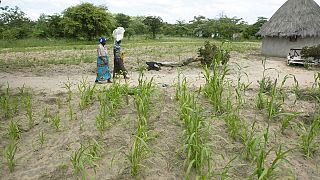Drought
Delicately and with intense concentration, Zanyiwe Ncube poured her small share of precious golden cooking oil into a plastic bottle at a food aid distribution site deep in rural Zimbabwe.
Her relief at the handout paid for by the U.S. government as her southern African country deals with a severe drought was tempered when aid workers gently broke the news that this would be their last visit.
Ncube and her 7-month-old son she carried on her back were among 2,000 people who received rations of cooking oil, sorghum, peas and other supplies in the Mangwe district in southwestern Zimbabwe.
The food distribution is part of a programme funded by American aid agency USAID and rolled out by the United Nations' World Food Programme.
They're aiming to help some of the 2.7 million people in rural Zimbabwe threatened with hunger because of the drought that has enveloped large parts of southern Africa since late last year.
It has scorched the crops that tens of millions of people grow themselves and rely on to survive, helped by what should be the rainy season.
They can rely on their crops and the weather less and less.
The drought in Zimbabwe, neighbouring Zambia and Malawi has reached crisis levels.
Zambia and Malawi have declared national disasters. Zimbabwe could be on the brink of doing the same.
It has reached Botswana and Angola to the west, and Mozambique and Madagascar to the east.
A year ago, much of this region was drenched by deadly tropical storms and floods.
It is in the midst of a vicious weather cycle: Damned by too much rain, then by not enough, it's a story of the climatic extremes that scientists say are becoming more frequent and more damaging, especially for the world's most vulnerable people.
In Mangwe, the young and the old lined up for food, some with donkey carts to carry home whatever they might get, others with wheelbarrows.
Those waiting their turn sat on the dusty ground.
Ncube, 39, would normally be harvesting her crops now, food for her, her two children and a niece she also looks after.
Maybe there would even be a little extra to sell. The driest February in Zimbabwe in her lifetime, according to the World Food Programme’s seasonal monitor, put an end to that.
“We have nothing in the fields, not a single grain. Everything has dried up,” she said.
The United Nations Children's Fund says there are “overlapping crises” of extreme weather in eastern and southern Africa, with both regions lurching between storms and floods and heat and drought in the last year.
In southern Africa, an estimated 9 million people, half of them children, need help in Malawi.
More than 6 million in Zambia, 3 million of them children, are impacted by the drought, UNICEF said. That's nearly half of Malawi's population and 30% of Zambia's.
While man-made climate change has spurred more erratic weather globally, there is something else parching southern Africa this year.
El Niño, the naturally occurring climatic phenomenon that warms parts of the Pacific Ocean every two to seven years, has varied effects on the world's weather.
In southern Africa, it means below-average rainfall, sometimes drought, and is being blamed for the current situation.
The impact is more severe for people like those in Mangwe, where it's notoriously arid and people grow the cereal grain sorghum and pearl millet, crops that are drought resistant and offer a chance at harvests.
This year, even they failed to withstand the conditions.
Francesca Erdelmann, the World Food Programme's country director for Zimbabwe, said last year's harvest was bad, but this season is even worse.
"This is not a normal circumstance,” she said.
The first few months of the year are traditionally the “lean months” when households run short as they wait for the new harvest.
However, there is little hope for replenishment this year.
Multiple aid agencies warned last year of the impending disaster.
Since then, Zambian President Hakainde Hichilema has said that 1 million of the 2.2 million hectares of his country's staple corn crop have been destroyed.
Malawian President Lazarus Chakwera has appealed for $200 million in humanitarian assistance.
The 2.7 million rural folk struggling in Zimbabwe is not even the full picture.
A nationwide crop assessment is underway and authorities are "dreading” the results, with the number needing help likely to skyrocket, said the WFP's Erdelmann.
USAID's Famine Early Warning System estimated that 20 million people would require food relief in southern Africa in the first few months of 2024.
With this year's harvest a write-off, millions in Zimbabwe, southern Malawi, Mozambique and Madagascar won't be able to feed themselves well into 2025.
Many just won't get that help as aid agencies also have limited resources amid a global hunger crisis and a cut in humanitarian funding by governments.
As the WFP officials made their last visit to Mangwe, Ncube was already calculating how long the food might last her.
She said she hoped it would be long enough to avert her greatest fear, that her youngest child would slip into malnutrition even before his first birthday.













01:35
Edgar Lungu's family condemns court decision to stop private burial in South Africa
00:52
South African court halts burial of Zambia’s ex-president Edgar Lungu
01:01
UN peacekeeper killed in CAR in attack by armed group near border with Sudan
01:15
Morocco says 2024 was the hottest year with temperatures reaching 47.7 degrees
00:45
Lungu funeral dispute settled between family and government
Go to video
South Sudan: UN warns of imminent famine